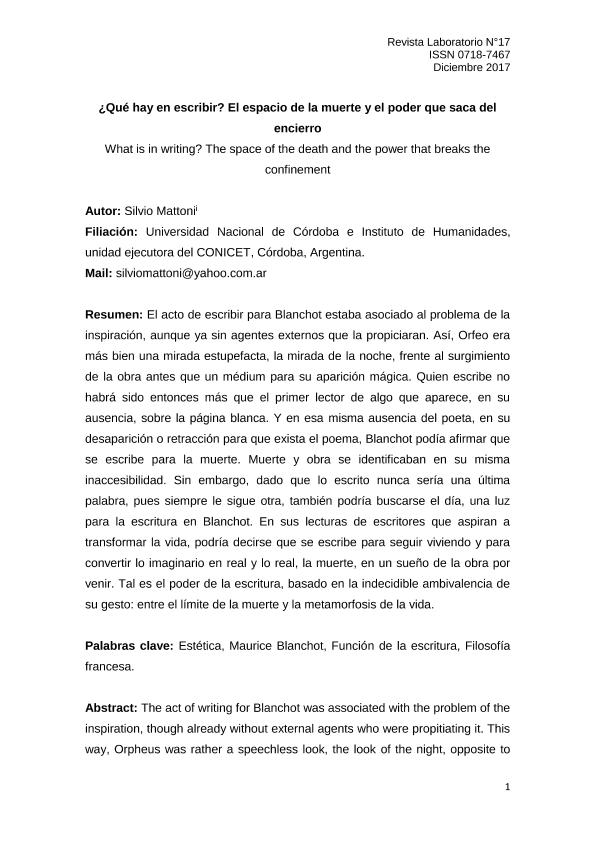Mostrar el registro sencillo del ítem
dc.contributor.author
Mattoni, Silvio Luis

dc.date.available
2018-11-26T13:58:30Z
dc.date.issued
2017-12
dc.identifier.citation
Mattoni, Silvio Luis; ¿Qué hay en escribir? El espacio de la muerte y el poder que saca del encierro; Universidad Diego Portales; Revista Laboratorio; 17; 12-2017; 1-17
dc.identifier.issn
0718-7467
dc.identifier.uri
http://hdl.handle.net/11336/65110
dc.description.abstract
El acto de escribir para Blanchot estaba asociado al problema de la inspiración, aunque ya sin agentes externos que la propiciaran. Así, Orfeo era más bien una mirada estupefacta, la mirada de la noche, frente al surgimiento de la obra antes que un médium para su aparición mágica. Quien escribe no habrá sido entonces más que el primer lector de algo que aparece, en su ausencia, sobre la página blanca. Y en esa misma ausencia del poeta, en su desaparición o retracción para que exista el poema, Blanchot podía afirmar que se escribe para la muerte. Muerte y obra se identificaban en su misma inaccesibilidad. Sin embargo, dado que lo escrito nunca sería una última palabra, pues siempre le sigue otra, también podría buscarse el día, una luz para la escritura en Blanchot. En sus lecturas de escritores que aspiran a transformar la vida, podría decirse que se escribe para seguir viviendo y para convertir lo imaginario en real y lo real, la muerte, en un sueño de la obra por venir. Tal es el poder de la escritura, basado en la indecidible ambivalencia de su gesto: entre el límite de la muerte y la metamorfosis de la vida.
dc.description.abstract
The act of writing for Blanchot was associated with the problem of the inspiration, though already without external agents who were propitiating it. This way, Orpheus was rather a speechless look, the look of the night, opposite to the emergence of the work before that a medium for his magic appearance. The one who writes will not have been at the time any more than the first reader than anything that appears, in his absence, on the white page. And in the same absence of the poet, in his disappearance or retraction in order that the poem exists, Blanchot could affirm that he writes himself for the death. Death and work were identified in the same inaccessibility. Nevertheless, provided that the written thing would never be a last word, since always it follows other one, also it might be looked the day, a light for the writing in Blanchot. In his writers’ readings that aspire to transform the life, it might be said that he writes himself to continue living and to turn the imaginary thing in real and the real thing, the death, in a dream of the work for coming. Such it is the power of the writing, based on the undecidable ambivalence of his gesture: between the limit of the death and the metamorphosis of the life.
dc.format
application/pdf
dc.language.iso
spa
dc.publisher
Universidad Diego Portales
dc.rights
info:eu-repo/semantics/openAccess
dc.rights.uri
https://creativecommons.org/licenses/by-nc-sa/2.5/ar/
dc.subject
Estética
dc.subject
Filosofía Francesa
dc.subject
Función de La Escritura
dc.subject
Maurice Blanchot
dc.subject.classification
Estudios Religiosos

dc.subject.classification
Filosofía, Ética y Religión

dc.subject.classification
HUMANIDADES

dc.title
¿Qué hay en escribir? El espacio de la muerte y el poder que saca del encierro
dc.title
What is in writing? The space of the death and the power that breaks the confinement
dc.type
info:eu-repo/semantics/article
dc.type
info:ar-repo/semantics/artículo
dc.type
info:eu-repo/semantics/publishedVersion
dc.date.updated
2018-10-19T15:36:53Z
dc.journal.number
17
dc.journal.pagination
1-17
dc.journal.pais
Chile

dc.journal.ciudad
Santiago
dc.description.fil
Fil: Mattoni, Silvio Luis. Consejo Nacional de Investigaciones Científicas y Técnicas. Centro Científico Tecnológico Conicet - Córdoba. Instituto de Humanidades. Universidad Nacional de Córdoba. Instituto de Humanidades; Argentina
dc.journal.title
Revista Laboratorio
dc.relation.alternativeid
info:eu-repo/semantics/altIdentifier/url/http://revistalaboratorio.udp.cl/que-hay-en-escribir-el-espacio-de-la-muerte-y-el-poder-que-saca-del-encierro/
Archivos asociados
